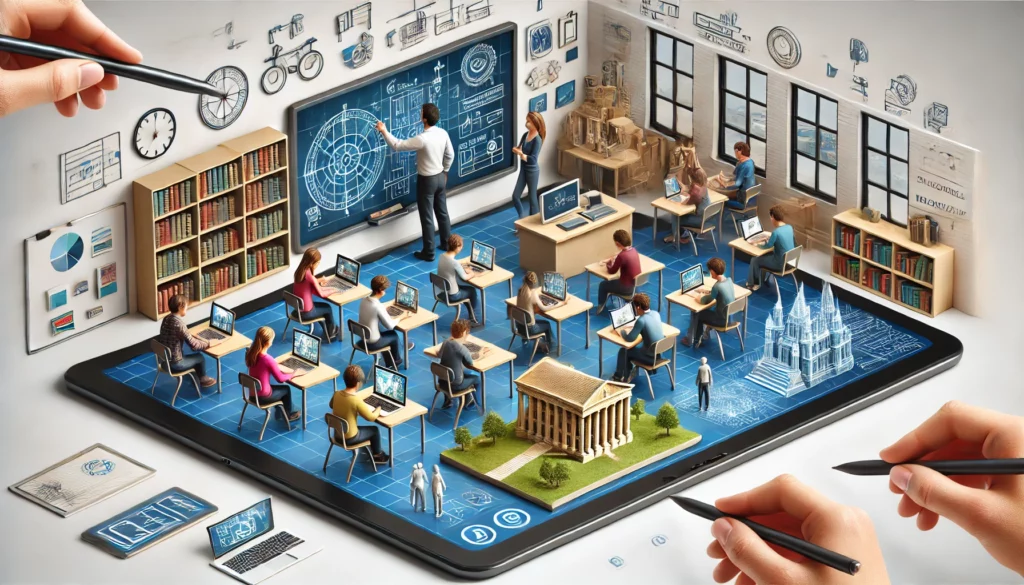Ads
Digital innovation is revolutionizing all sectors of society, and education is no exception.
Schools and universities around the world are adopting cutting-edge technologies to improve the learning experience, making it more dynamic, accessible, and personalized.
Let's explore how this trend is shaping the future of education and why you should be interested in this topic.
The Impact of Technology in the Classroom
In recent years, the use of electronic devices and digital platforms has become common in schools.
Tablets, laptops, and interactive whiteboards are no longer a luxury, but essential tools to facilitate learning.
Ads
An example of this is Google Classroom, which allows teachers to organize assignments, share materials, and provide real-time feedback.
In addition, many schools are implementing augmented reality (AR) technology.
Imagine a history class where students can explore an ancient city through their mobile devices! This is not only fun, but it also improves their understanding of the material.
Educational Platforms That Are Making a Difference
One of the biggest digital transformations in education has come with online platforms.
Apps like Duolingo, Coursera, and Khan Academy have revolutionized the way people learn.
Let's talk a little more about each of them:
- DuolingoWith a gamified system, this application helps students learn new languages in a fun and efficient way.
- CourseraPartnerships with renowned universities offer courses in diverse areas, from computer science to the arts.
- Khan AcademyA free platform that covers disciplines such as mathematics, science, and history, ideal for students of all ages.
These tools make learning accessible anytime, anywhere, which is essential in the modern world.
Artificial Intelligence in Education
Artificial intelligence (AI) is also playing a significant role. Intelligent tutoring systems, such as “Smart Sparrow,” personalize learning based on each student’s progress.
It's like having a private tutor who understands exactly what you need to improve on.
Another interesting use of AI is the automation of administrative tasks.
With AI-based systems, schools can automate class scheduling, calendar organization, and even exam grading, allowing teachers to focus more on teaching.
Challenges of Digital Innovation in Education
Despite all the benefits, there are also challenges. Inequality in access to technology is one of the main barriers.
Not all schools have the resources to implement modern tools, which can increase the educational gap between students from different regions or socioeconomic conditions.
Another challenge is teacher training. It's not enough to have the technology; educators need to know how to use it effectively.
Training programs are essential to ensure the success of digital innovation.

The Role of Parents and the Community
Did you know that family involvement is crucial in this process? When parents and caregivers get involved, they can help children use technology safely and productively.
After all, with so many distractions online, it's important to teach good digital practices early on.
Future Trends: What to Expect?
The future of digital innovation in education promises to be even more exciting.
Let's look at some trends that are coming:
- GamificationThe use of games to teach complex concepts.
- Project-based learning: Stimulation of creativity and solving real problems.
- Virtual reality (VR)A complete immersion in educational experiences.
Conclusion: A Revolution That Benefits Everyone
Digital innovation in schools and universities is much more than a trend; it is a necessity.
By adopting these technologies, we are preparing future generations for an increasingly digital and dynamic world.
And you, what do you think of this movement? Share this article with your friends and family so that more people can reflect on the impact of technology on education.
If you want to learn more about tools and applications that are revolutionizing teaching, check out the download links below.
Take advantage and start exploring these possibilities today!
Frequently Asked Questions about Digital Innovation in Schools and Universities
1. What is digital innovation in education?
Digital innovation in education involves the use of advanced technological tools, such as electronic devices, online platforms, and artificial intelligence, to improve teaching and learning methods. Its goal is to make education more interactive, personalized, and accessible.
2. What are the main benefits of technology in the classroom?
The benefits include increased student engagement, access to educational resources at any time, personalized learning, and a deeper understanding of subjects through technologies such as augmented reality and intelligent tutoring systems.
3. Which digital platforms are popular in education?
Some of the most prominent platforms are Duolingo, for learning languages in a gamified way; Coursera, which offers online courses from recognized universities; and Khan Academy, a free platform for learning key subjects such as mathematics and science.
4. How does artificial intelligence contribute to learning?
Artificial intelligence personalizes learning, identifies areas for improvement for each student, and automates administrative tasks, allowing teachers to focus on teaching. It is also used in tutoring and assessment systems.
5. What are the challenges of implementing technologies in schools?
The main challenges are inequality in access to technological devices, the lack of resources in some schools, and the need to train teachers in the effective use of these tools.
6. How can parents support digital innovation in education?
Parents can get involved by monitoring technology use, promoting good digital practices, and motivating their children to take advantage of available educational tools.
7. What future trends are expected in digital education?
Advances such as gamification, project-based learning, the use of virtual reality for immersive experiences, and greater integration of innovative technologies in the classroom are anticipated.